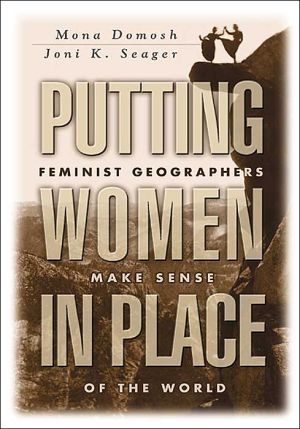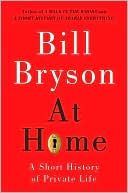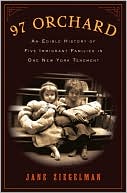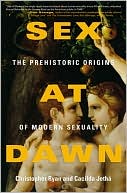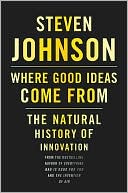Putting Women in Place: Feminist Geographers Make Sense of the World
Why do women and men tend to work in different jobs, in different ways, and in different spaces? Which is more "masculine"--the city or the suburbs? Why is nature often represented in feminine form? This thought-provoking book uses the lens of gender to provide an illuminating new perspective on the geography of everyday life. Domosh and Seager show how notions of maleness and femaleness have influenced our built environment, the locations in which we invest meaning, and the ways we live,...
Search in google:
Why do women and men tend to work in different jobs, in different ways, and in different spaces? Which is more "masculine"--the city or the suburbs? Why is nature often represented in feminine form? This thought-provoking book uses the lens of gender to provide an illuminating new perspective on the geography of everyday life. Domosh and Seager show how notions of maleness and femaleness have influenced our built environment, the locations in which we invest meaning, and the ways we live, work, travel, and explore. From the arrangement of furniture in Victorian homes to the movements of refugees over contemporary borders, the book explores gender patterns and roles across cultures and historical periods. It is lavishly illustrated with line drawings, photographs, and maps. Booknews Domosh (geography, Dartmouth College) and Seager (geography, the University of Vermont) use gender as a lens for looking at the geography of everyday life. They show how notions of maleness and femaleness have influenced the built environment and the ways in which we live, work, travel, and explore. Discussion ranges from the arrangement of furniture in Victorian homes to the movements of refugees over contemporary borders, exploring gender patterns and roles across cultures and historical periods. Includes b&w historical photos and illustrations. Annotation c. Book News, Inc., Portland, OR (booknews.com)
Putting Women in Place\ Feminist Geographers Make Sense of the World \ \ By Mona Domosh Joni Seager \ The Guilford Press\ Copyright © 2001 The Guilford Press\ All right reserved.\ ISBN: 1-57230-668-8 \ \ \ \ Chapter One\ The City \ Ally McBeal, the angst-ridden heroine of the TV show of the same name, manages to do much of her soul searching while fearlessly strolling the moonlit streets of downtown Boston alone. A latter-day Mary Tyler Moore, Ally and her other single, female, lawyer friends take to the city streets (and bars, restaurants, and clubs) unabashedly and with aplomb: they shout in celebration, step in tune to a "theme" song, or use the city's anonymity to gather their thoughts. The city is their playground and their site of redemption from emotional distress.\ Fantasy? Well, of course it is-Ally McBeal is a TV sitcom. But the romantic imagery of cities as sites of rumination and pleasure is longstanding, perhaps dating back to the beginnings of modernism-to the poetry of Baudelaire or Whitman and the celebration of the lone man wandering the streets of nineteenth-century Paris or New York, commenting and reflecting on the rough-and-tumble lives being lived out around him. The city has often been portrayed as risqué and exciting. Historically, it has most often been men who are able to enjoy those pleasures. But Ally too is a flaneur and a voyeur-she wanders the streetsseemingly without purpose and stares longingly at lovers kissing under streetlamps. Does it tell us anything about changing gender roles and/or about postmodern cities that a single woman is now portrayed as the hero of the street? Are our early-twenty-first-century cities qualitatively different from the nineteenth-century city of Baudelaire and Whitman? And what about the suburbs, those safe but sometimes dull places that have often been portrayed as domestic and therefore suitable for women and children. Neither Ally nor any of her friends live in or visit the suburbs (though presumably after they are married and have children, they will move into single-family houses in Newton or Burlington, Massachusetts), nor did Baudelaire or Whitman excite us with tales of the countryside.\ The urban imagery of Ally McBeal (as well as other recent sitcoms like Friends and Seinfeld) is certainly different from the urban image on the TV news that follows the show on the Fox network: drug shootings on the streets, assaults, rapes, carjackings. The city here is depicted as the site of threatening behavior, particularly for women, and particularly for lone women at night wandering the streets. And yet there's Ally, alone with her thoughts, at night, strolling the streets!\ We seem to be caught between two opposed images of the city: one offers the city as an exciting and fulfilling place for women (and hence "good" for women), and the other offers a potentially dangerous place (and thus "bad" for women). Suburbs, too, are portrayed in contradictory ways: on the one hand, they are portrayed as more safe than cities, and therefore "better" for women; on the other hand, they are presented as spatial traps, where women get stuck in domestic roles with no way to escape (and therefore "bad" for women). How can we make sense of these contradictions? In reality, the contemporary urban landscape contains all facets of these images: it presents the possibilities of economic advancement and social excitement that we see in Ally McBeal, but it also constricts the physical and social movement of many women. The suburbs are environments in which some women thrive, but in which others are stifled. Our cities are complex environments, in which various neighborhoods resonate with different gendered and often racialized meanings. The twenty- and thirty-story office buildings that mark our downtowns express the corporate and masculine dominance of our political economy; our decaying inner-city cores, home to many working-class and minority citizens, are imagined as dangerous, most especially off limits to middle-class white women; gentrified neighborhoods, marked by rehabilitated historical structures and trendy restaurants, are often home to gay and lesbian communities. Homeless people wake up in an urban park while "yuppie" businessmen and businesswomen jog by on their morning exercise route. In a gentrified neighborhood, Jamaican nannies with strollers take their white "charges" (babies) to the nearby grocery store. Middle-class women in the suburbs ply the roads back and forth to the shopping mall. Our cities are varied and vibrant places, with opportunities for economic and social success, but they are also sites that restrict and enclose possibilities. How can we make sense of this somewhat chaotic scene? How do feminist geographers "read" the contemporary urban landscape?\ To start, we need to understand that contemporary cities are constructed from layers of past structures, traditions, ideologies, and beliefs, and that any explanation of urban patterns and processes must take into account their historical contexts. Many of us live in cities that formerly were great industrial powers; their landscapes are littered with decaying built forms that once facilitated the movement of raw materials and their transformation into finished manufactured products. Others of us are surrounded by "postindustrial" landscapes: office parks and shopping centers, interlinked with highways. Still others navigate walkways that may date to the late medieval era. Each of these landscapes tells us something about the gendered relationships and gender roles that were played out in the times they were built. Those pasts continue to shape our contemporary social scene. In addition, some of our most powerful assumptions about cities and gender are rooted in a distant past. One of the most powerful of these is the assumption that the city is somehow more masculine, that it is men who are allowed to enjoy its pleasures (although Ally is telling us things may have changed, at least for a few women), while the suburbs are more feminine. Where do these associations come from? What do they tell us about the contemporary worlds in which we live?\ MASCULINE CITY, FEMININE COUNTRY?\ In the Euro-American tradition, we can trace the historical roots of this powerful association at least as far back as the Renaissance. Urbanist Elizabeth Wilson (1991) suggests that it was during this period (roughly 1400-1650) that the city came to be seen as masculine, in distinction to a feminine countryside. During the Renaissance, the city was envisioned as an arena where the ideals of the mind-coded as masculine-could be expressed literally and symbolically. Renaissance urban thinkers and designers thought of the city as a unified, visual whole, that should reflect rational, geometric principles, as Figure 3.1 demonstrates. The plan of Palma Nuova, designed by Vitruvius, showcases the geometric regularities that were thought to create ideal forms for urban life. These principles were exactly the ones assigned by Renaissance thinkers to the male sphere. Other qualities of human life, for example, those that pertained to the body and to the organic, were assigned to the female sphere. The countryside (with its more earthy connotations) and the older medieval city were seen as the realm of the feminine. This association of the city with the masculine and the rational served to align the power of the new city with men.\ Medieval cities were portrayed by Renaissance commentators as feminine since they represented many of the qualities that the new order disdained. Medieval European cities grew without central planning or authority, that is, they developed organically. As population expanded in the medieval city, or as trade increased, new buildings were simply added next to the old ones. Walkways and roadways appeared haphazardly, as the need arose. From an aerial perspective, medieval cities appear chaotic, resembling a series of congeries or clusters of development appended to each other, as Figure 3.2 illustrates. This is not to suggest that there was no logic to these urban forms. On the contrary, as urban geographers have demonstrated (Vance, 1990; Carter, 1983), the form of medieval cities was well suited to the demands of medieval society and economy.\ The early forms of capitalism that characterized the Renaissance, however, brought new class formations and new demands to the city. One of those demands was for better circulation within the city and between the city and the countryside. The urban forms that were idealized by such Renaissance urban commentators as Leon Battista Alberti and Thomas More in the fifteenth and sixteenth centuries were set in distinction to the medieval organic form. The new cities of the Renaissance could be visualized from afar as rational wholes, not as organic patches attached to each other in haphazard and unplanned ways.\ Americans have inherited from the European intellectual tradition a way of conceptualizing the city that dates from the Renaissance. The modern U.S. city is rational, planned, orderly; in other words, it is masculine. The countryside on which the city is imposed is represented as feminine. The city is seen as the expression of the human intellect's dominance over nature-man controls nature. Elizabeth Wilson (1991) argues, therefore, that the feminine in the city has always represented a challenge to that rational world; the feminine represents the disorderly, the chaotic, the unknowable. And although this may seem a rather abstract idea, it has real implications: the presence of women on the streets of the city has invariably been seen as problematic, as we will argue throughout this chapter.\ THE EARLY MODERN CITY\ Most Renaissance cities had medieval (or even older) antecedents. Only a few Renaissance cities were built from scratch. Palma Nova, completed in 1593 in northern Italy, shows this ideal form. For the most part, the ideals of rational urban planning with grand visual spectacles were limited by reality-most societies lacked the financial and technological means to completely reconstruct medieval urban forms. The changes that occurred in urban infrastructure happened slowly and incrementally. Most urban dwellers in the early modern period (1500s-1700s) occupied dwellings and worked in structures dating from the medieval period. Yet the changes in social and economic power wrought by early forms of capitalism during this period were both reflected in and comprised of changes in the spatial layout and three-dimensional forms of the city.\ We can see some of these forces shaping London, for example, a city that rose to dominance during this time period. In medieval London, most craftspeople and merchants lived above their shops, combining in one location work and home. Women were typically engaged in productive labor with their fathers or husbands, or were involved in their own forms of commerce such as selling produce, making and selling cloth, or brewing and selling beer.\ Yet as England's control over seagoing trade increased during the early modern period, production and sales activities expanded. A London merchant who traded in woolen cloths, for example, would find both the supply of wool and demand for his cloth on the increase. He needed a place to store his inventory close to the docks where his ship was moored, and perhaps a separate location close to the main market and banking facilities in the center of London for his office. Finding space on the first floor of his residence no longer useful for business, he might convert it into larger and more elegant living quarters for his family. Or, as his business became more successful, he might decide that his family should move out of its old and now unstylish medieval dwelling to a house in one of the newer areas of the city.\ Those new residential districts were located on the western edges of medieval London, close to Westminster, home to the royal court, and therefore close to the aristocracy. This lent an air of nobility to this new class of merchants, and helped legitimize their newfound wealth and power. Merchant residential areas, such as Covent Garden and Bloomsbury Square, were now important symbols of the wealth and status of the families who resided in them.\ In modernizing London, not only did work and home become physically separated from each other in the city, but each became important indicators of new identities and values. As we mentioned in Chapter 1, it was during this time period, the fifteenth to the seventeenth centuries, that the values associated with the private realm of home and those with the public realm of work came to be defined in distinction to each other. The new masculine, public sphere was defined by values of egalitarianism and economic utility, while the feminine, private sphere was governed by the value of familial deference and emotional ties. These distinct value systems were expressed and reinforced in space. The workplace for the new merchant expressed his business acumen, while his home expressed his culture and style. Although still involved in work in their homes, the wives of these merchants were now increasingly in charge of representing their family's new cultural identity-that is, their jobs now included home decoration, knowing and using correct manners and etiquette, creating ornamental and beautiful gardens, and clothing their families in appropriate styles.\ These immense spatial and ideological changes did not happen quickly, nor did these changes affect everyone in the same way. Nevertheless, cities like London were massively reorganized both physically and symbolically, as they emerged from medievalism into modernism (Bowden, 1975). Recent scholarship on London has revealed the ways in which masculine and feminine identities were expressed in the public spaces of early modern cities (Solkin, 1992; Habermas, 1991; Ogborn, 1998). New retailing and residential areas circumscribed an emerging feminine sensibility. In London in the eighteenth century, as in many other large European cities at the same time, shops were moved indoors and clustered in areas near their former outdoor market sites. Previously, when goods needed to be placed indoors, they were often moved to the first floor of houses that lined the outdoor market space, not to spaces specifically set aside for selling and buying. The new shops of the eighteenth century, however, were devoted to the processes of consumption-to the ritualized bartering process that was now moved from the public marketplace into the semiprivate interior space of the shop.\ According to Elizabeth Kowaleski-Wallace (1997), this development of interior spaces designed for selling went hand in hand with the evolution of gendered roles and "performances" within the stores: the business of selling was "figured" in masculine terms, while the activities associated with buying were "figured" as feminine.\ \ Continues...\ \ \ \ Excerpted from Putting Women in Place by Mona Domosh Joni Seager Copyright © 2001 by The Guilford Press. Excerpted by permission.\ All rights reserved. No part of this excerpt may be reproduced or reprinted without permission in writing from the publisher.\ Excerpts are provided by Dial-A-Book Inc. solely for the personal use of visitors to this web site. \ \
Figures and TablesAcknowledgmentsPrefaceCh. 1Home1The Separation of Spheres2At Home with the Victorians6Tastemakers and Home Engineering14Social Engineering20The Suburban Home24The Postmodern Home28Home-Work Relations30Ch. 2Women at Work35What Is Work?38What Counts?41Footloose Factories and Nimble Fingers: The New Industrial Order47Homework53The Return of the Sweatshop56Between the Sticky Floor and the Glass Ceiling57Gender in the Workplace58Mapping the Terrain of Poverty63Ch. 3The City67Masculine City, Feminine Country?69The Early Modern City72The Industrial City76The Modern City95The Postmodern City99Ch. 4On the Move110The Body in Space110Getting Around: First Principles113Keeping Women in Their Place115Roaming and "Homing"118Breaking the Bonds of Space and Sex122Auto-masculinity123Global Migration129Refugees134The Sex Trade136Ch. 5Nations and Empires140Victorian Lady Travelers143Women and Colonial Space146Feminism and Imperialism156Gender and Nationalism160Women in Nationalist Movements168Nationalisms and Sexualities170Ch. 6The Environment174Mothers and Other Forces of Nature174Control179Encounters in the Environment184Studying Nature186Environmental Perception188Environmental Activism and Ecofeminism188References195Index209About the Authors216
\ From the Publisher"This book has two strengths. First, it covers historical and contemporary viewpoints, enabling the reader to understand the role that women contributed to change over space through time. Second, the work contains studies at various scales, ranging from the local to the global....the book is an excellent introduction to the geography of gender and is also recommended to nongeographers. An excellent feature is the liberal number of maps, photographs, and drawings. Lower-division undergraduates and above."--Choice\ "For too long, Anglophone geography has lacked a comprehensive introductory text on gender issues. Putting Women in Place answers this need. The text's strength lies in its attention to the central debates and concerns of the many subfields of human geography, and its balanced approach to both historical and contemporary examples. It will serve as an important anchoring text for introductory gender and geography courses, as well as a companion text for geographically oriented introductory courses in women's studies."--Sallie Marston, Department of Geography and Regional Development, University of Arizona\ "Most geographical studies assign women an invisible place in space. It is man who explores, names, and dominates while woman remains invisible. This book offers a broad account of the variety and complexity of gendered roles in both time and space, whether in the domestic environment, the workplace, the city, the imperial colony, or the natural environment. From single women as homesteaders on the American frontier, to lady Victorian explorers finding freedom and release through travel, to super-moms in the suburbs carrying out their multiple roles, Domosh and Seager offer a compelling account of how definitions of femininity are forged in space."--M. Christine Boyer, School of Architecture, Princeton University\ "Putting Women in Place: Feminist Geographers Make Sense of the World is a lively and well-illustrated overview of the geography of women. Treating both historical and contemporary issues, Domosh and Seager provide a feminist perspective on space and gender. For many years, I have wanted to be able to assign a book like this. I recommend it for graduate and undergraduate courses in geography, history, architecture, and urban studies. --Dolores Hayden, Professor of Architecture, Urbanism, and American Studies, Yale University, author of The Grand Domestic Revolution: A History of Feminist Designs for American Homes, Neighborhoods, and Cities\ \ \ \ \ \ \ BooknewsDomosh (geography, Dartmouth College) and Seager (geography, the University of Vermont) use gender as a lens for looking at the geography of everyday life. They show how notions of maleness and femaleness have influenced the built environment and the ways in which we live, work, travel, and explore. Discussion ranges from the arrangement of furniture in Victorian homes to the movements of refugees over contemporary borders, exploring gender patterns and roles across cultures and historical periods. Includes b&w historical photos and illustrations. Annotation c. Book News, Inc., Portland, OR (booknews.com)\ \
